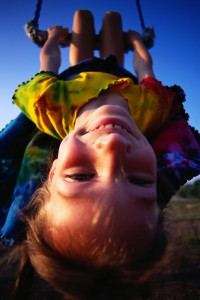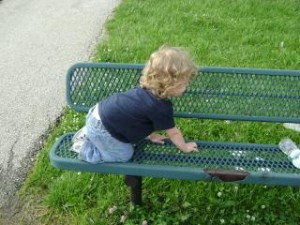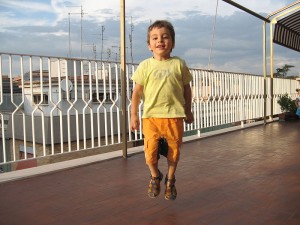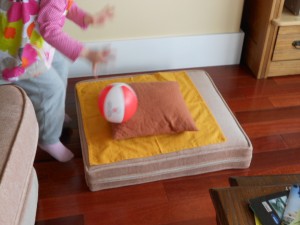Brains are wired to learn through sensory stimulation, and two important senses are movement and the sense of the body’s position in space. Yesterday’s post discussed the kindergarten readiness fun and learning that can happen on the playground in terms of ways the body moves. Today’s post is based on the body in space.
 Decades ago there was a program on television called “Lost in Space”. Basically, that’s what babies are and they need to learn where in space their bodies are and where their body parts are in relation to each other. Toddlers and preschoolers are still learning this and need lots of experiences. Playgrounds are great places to explore all the ways a body can be in space. On the slide, the body is up and in less than a minute, it’s down. Sliding down fire pole is even faster for going from the top to the bottom. Bodies go back and forth in space on a swing. Hanging from the monkey bars is a way to explore being upside down. The feeling of space is very different at the top of the climber than it is down on the ground.
Decades ago there was a program on television called “Lost in Space”. Basically, that’s what babies are and they need to learn where in space their bodies are and where their body parts are in relation to each other. Toddlers and preschoolers are still learning this and need lots of experiences. Playgrounds are great places to explore all the ways a body can be in space. On the slide, the body is up and in less than a minute, it’s down. Sliding down fire pole is even faster for going from the top to the bottom. Bodies go back and forth in space on a swing. Hanging from the monkey bars is a way to explore being upside down. The feeling of space is very different at the top of the climber than it is down on the ground.
 At the playground, kids also get to try various combinations of body part togetherness. On the monkey bars hands are hanging down in the same position while on the climber one is up and one is down. That is the same case for feet. Walking on balance boards is especially challenging for body parts and body position. Before attempting the balance boards, kids can practice balancing and moving on benches. Most of the time, feet support and move the body in space, but at the playground hands can do that. Some playgrounds will have horizontal ladders or a series of rings where kids can swing across going from hand to hand.
At the playground, kids also get to try various combinations of body part togetherness. On the monkey bars hands are hanging down in the same position while on the climber one is up and one is down. That is the same case for feet. Walking on balance boards is especially challenging for body parts and body position. Before attempting the balance boards, kids can practice balancing and moving on benches. Most of the time, feet support and move the body in space, but at the playground hands can do that. Some playgrounds will have horizontal ladders or a series of rings where kids can swing across going from hand to hand.
Instead of being “Lost in Space” can your child be “Found at the Playground?”


